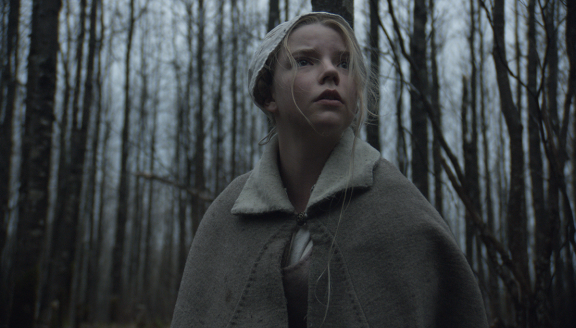By Terrill Smith (Contributor) – Email
Set in early 17th century New England, The Witch follows a family of Puritans who are exiled from their community for heresy and forced to live alone on the edge of a large, ominous forest. One day when the eldest child, a daughter named Tomasin (Anya Taylor-Joy), is playing with the infant child of the family, Samuel, the baby inexplicably disappears. Almost immediately a series of increasingly devious events begin to occur, culminating in claims of sorcery and witchcraft against Tomasin that threaten to unravel the family.
This debut from writer / director Robert Eggers works on multiple levels, notably as a slow-building horror film and faithful historical drama, centering on both the religious hysteria and madness associated with witchcraft and superstition in colonial America. Although marketed as pure horror, Eggers’ concerns are with recreating, in painstaking detail, a God-fearing New England decades before the Salem Witch Trials. To this end, the 17th century clothes, lodging, and period-accurate vernacular are employed with historical authenticity, while cheap tricks and jump scares are eschewed in favour of the types of meditative visuals and insidious encounters found in New England folk tales.
Indeed, shortly after Samuel disappears, the family’s crops begin to fail, a large rabbit starts wreaking havoc, and young twins Mercy and Jonas (Ellie Grainger and Lucas Dawson) begin talking to their menacing farm goat, whom they call “Black Phillip.” While these events are not immediately horrifying, the way in which Eggers situates them within an oppressive atmosphere serves to create a constant feeling of dread. The grey New England skies become darker, Black Phillip starts acting wildly, and the woods take on an evil presence, indicated through menacing music and austere cinematography.
In essence then, what scares the viewer is not the things that are seen, but those dreadful elements which remain hidden, creating an under-the-skin type of horror. Why is Black Phillip acting so wildly? If he actually is speaking with the children, then who or what is he, and what is he saying? This is good horror — akin to recent critic favourites The Babadook and It Follows, The Witch generates fear through the unseen. While the film could thus elicit criticism for being too uneventful or slow-moving, the nature of fear is fundamentally primal, most effectively triggered by the unknown and unexplained.
The eldest son, Caleb (Harvey Scrimshaw), eventually becomes possessed after being lured by a mysterious young woman into her woodland home. By this time, the audience feels the family’s terror, desperation, and yearning for absolution, and this is what makes the film such an effective piece of horror cinema. That is, the family’s shocking heights of suspicion and paranoia are echoed in those same feelings encountered by the audience, creating a truly immersive cinematic experience. Ultimately, while mainstream horror offerings like Sinister and The Purge provide audience-pleasing shocks and resolutions, The Witch offers neither. And it is for this reason that the movie is so great, since it quietly gets under the skin of viewers and lingers there for days afterwards.



